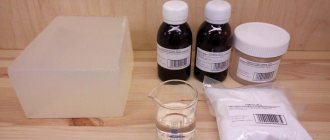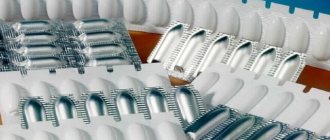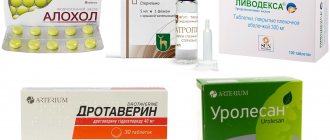Eye infections are very common among people of all ages and professions.
They occur with bacterial, viral, fungal damage to the mucous membrane, and a decrease in protective immune forces.
In this condition, doctors give preference to local antibiotic therapy.
Antibiotics in the form of eye drops are a convenient form for use with minimal side effects. The drug is almost not absorbed from the surface of the cornea, but accumulates in the superficial tissues of the eye. An antimicrobial solution inhibits bacterial activity and reduces infectious inflammation.
Release form and composition
Sulfacyl sodium eye drops are a colorless liquid. They contain the active ingredient of the same name; its content in 1 ml of solution is 200 mg.
Excipients are purified sterile water (water for injection), sodium thiosulfate, 1 M hydrochloric acid solution. The eye drop solution is contained in a 10 ml polyethylene bottle. The cardboard pack contains one bottle of the drug, as well as instructions for use.
Drug interactions
Sulfacyl sodium cannot be prescribed with all medications. Thus, when used simultaneously with Novocaine or Lidocaine, the antibacterial properties of the drug decrease. Albucid should not be used simultaneously with salicylates, as they increase the toxicity of the drug and the risk of side effects increases, even when used in therapeutic dosages.
If Albucid is used together with anticoagulants, the activity of the latter drugs increases markedly. Do not forget that sodium sulfacyl is strictly prohibited from being used simultaneously with drugs that contain silver salts.
If a person regularly takes any medications, the doctor should be informed about this. This will avoid severe side effects.
pharmachologic effect
The active ingredient of the drug - sulfacetamide - is a substance from the group of sulfonamides with an antimicrobial bacteriostatic effect. The mechanism of its action is explained by inhibition of dihydropteroate synthetase, competitive antagonism with para-aminobenzoic acid, as well as the ability to disrupt the synthesis of tetrahydrofolic acid, necessary for the synthesis of pyrimidines and purines.
Sulfacyl sodium is active against gram-negative and gram-positive cocci, Actinomyces israelii, Bacillus anthracis, Chlamydia spp., Corynebacterium diphtheriae, Clostridium perfringens, Escherichia coli, Yersinia pestis, Vibrio cholerae, Shigella spp., Toxoplasma gondii.
Characteristics and therapeutic properties of "Albucid"
The ophthalmic product is a homogeneous transparent liquid with a slightly alkaline reaction . The percentage saturation of sulfacetamides varies from 20% for pediatric use to 30% for adult patients.
The release form includes a bottle with or without a dispenser, volume 5 and 10 ml.
Interesting! The international name of eye drops is “Sulfacetamide”, the second identical name of which is “Albucid”.
The composition of the medication is represented by the following components:
- hydrogen chloride;
- sterile aqueous base;
- sodium sulfacetamide monohydrate.
The latter component is characterized by similar chemical properties to para-aminobenzoic acid (the main product for maintaining the vital activity of bacteriological organisms).
The result of the interaction of sulfonamide with pathogenic microbes is inhibition of the synthesis of pyrimidine and purine bases . Stopping DNA replication negatively affects the ability of bacteria to reproduce, causing single-celled organisms to die within a short period of time .
The active ingredients of the drug are active against gram-positive and gram-negative pathogenic microorganisms.
Indications for use
What does sodium sulfacyl help with? Eye drops are used for:
- gonorrheal eye diseases;
- conjunctivitis;
- blepharitis;
- blenorrhea;
- purulent corneal ulcers and other eye pathologies.
The drug can be used by both children and adults, including for the prevention of blenorrhea in infants. In the case of purulent processes, it stops them and accelerates the healing of the cornea.
Prescribed for the treatment of streptoderma and staphyloderma, infections caused by Escherichia coli.
The medicine can be used orally in the case of colibacillary urinary tract infections, mastoiditis, puerperal sepsis and other infectious diseases.
Prescription for newborns
In Russia and the CIS countries, all newborn babies are instilled with a solution of Sulfacyl sodium at a concentration of 30%. The goal is the prevention of ophthalmoblennorrhea. The disease occurs as a result of infection when passing through the birth canal of the mother. The active substance destroys gonococci and other pathogenic organisms that enter the baby's eyes. The infectious-inflammatory process does not start.
In the following days, Sulfacyl sodium is instilled as needed to treat an ophthalmological disease. If the solution is used for several days in a row, it makes sense to prescribe the solution at a concentration of 10% or 20%. A 30% concentration is too high, so using the product every 6 hours may harm the child’s health.
The baby is instilled with 2 drops of the solution at intervals of 4 to 6 hours for 7 days. Both eyes are treated, even if the pathology affects only one of them.
Instructions for use
Sulfacyl sodium is used topically, instilled into the conjunctival sac of the affected eye. Recommended dosage:
- chlamydial and gonorrheal eye diseases in adults: 1-2 drops up to 6 times a day for a course of 4-6 weeks. If positive dynamics are noted, each subsequent week the number of instillations is gradually reduced;
- conjunctivitis in adults and children: on the first day, 1-2 drops every hour, in the next 3-4 days the number of instillations is reduced to 5-6 per day;
- blepharitis in children and adults: at the beginning of treatment - 1-2 drops up to 8 times a day, as the condition improves, the number of instillations is reduced to 3-4 per day. The course of treatment is 3–5 days;
- purulent corneal ulcer: 1-2 drops 5-6 times a day for 5-7 days;
- prevention of blenorrhea in newborns: 2 drops into the conjunctival sac of each eye immediately after birth, then 2 drops at 2-hour intervals throughout the day;
- treatment of blenorrhea: 2 drops every 1–2 hours during the first day, then every 3 hours. The course of treatment is 2 weeks.
Therapeutic effect and scope of application
Sulfacyl sodium is classified as a sulfonamide drug. It is characterized by a wide spectrum of antimicrobial activity. This group of drugs was developed several years before the advent of antibiotics to treat infections. Drops are used to treat infectious diseases of various eye structures.
The key therapeutic effect of sodium sulfacyl is the ability to destroy pathogenic microflora. This action is ensured by the active component. It blocks the production of enzymes involved in the synthesis of pyrimidine and purine compounds. They act as components of the DNA of pathogenic microbes.
As soon as DNA synthesis of a microbial cell stops, it loses the ability to reproduce. Within a limited period of time, most of the pathogens are killed. The bacterium lives for the required period and dies without reproducing.
Groups of bacteria against which sodium sulfacyl is active:
- escherichia coli,
- cholera vibrios,
- shigella,
- diphtheria bacillus,
- toxoplasma,
- chlamydia.
After Sulfacyl sodium enters the conjunctival sac, the active substance begins to act. The maximum effect is observed after half an hour. The key component penetrates the iris and eyeball. If the damage concerns the epithelial tissue of the cornea, the medicine penetrates into the deeper layers at double speed.
Children, pregnancy and breastfeeding
Systemic absorption of the drug when applied topically is minimal. The drug can be used during pregnancy and breastfeeding according to indications.
Use in children and newborns
Sulfacyl Sodium for children is used in a dosage of 2-3 drops (20% solution). The child should be in a sitting or lying position. You should carefully open your eyelids and drip the medicine. It is recommended to start from the place where the inflammation is less pronounced.
In case of acute otitis media, the drug is instilled into the ears. It can be diluted in boiled water 2-4 times.
Newborns
Medicine for newborns, as a rule, is instilled immediately after birth to prevent the development of blenorrhea.
In addition, Sodium Sulfacyl is often used in the nose of infants. The doctor prescribes this remedy for a prolonged runny nose, especially when it comes to a bacterial infection. It should be borne in mind that if the drug gets into the nose, it can cause a burning sensation, which is why the child begins to be capricious.
Contraindications and side effects
Sulfacetamide is so safe that there are practically no contraindications to it. Albucid, like Sulfacyl sodium, should not be used if you are hypersensitive to any of the components included in the eye drops.
The most common side effects after instillation of the drug in patients were:
- redness, itching or swelling of the upper (lower) eyelids,
- irritation, burning or tingling sensation in the eyes,
- photophobia,
- temporary visual impairment,
- allergic reaction.
If one of the listed symptoms appears, you should stop instilling the drug and consult an ophthalmologist - he will replace the antibiotic with another similar medicine.
The systemic effect of sulfacetamide when applied topically has not been observed to date, since a small amount of the active substance is absorbed into the systemic circulation.
special instructions
Before starting to use Sulfacyl sodium eye drop solution, it is important to carefully read the instructions for the medication. Persons who have hypersensitivity to drugs of the pharmacological group thiazide diuretics and sulfonylureas may also have individual intolerance to sulfonamides.
Immediately after eye drops, it is not recommended to perform work that requires sufficient clarity of vision. Drug interactions
If you need to take other drugs in combination with Sulfacyl Sodium, you should consult your doctor.
The bacteriostatic effect of the drug is reduced when combined with Novocaine, Anestezin and Dicaine. And its toxicity increases when interacting with Diphenin, salicylates and para-aminosalicylic acid. When used together with indirect anticoagulants, their specific activity may increase.
Drops should not be used together with salts of some alkaloids, with agents containing silver salts, with zinc sulfate, as well as with acids and substances that have an acidic reaction.
Adverse reactions
The occurrence of side effects is extremely rare, and they are usually associated with overdose and frequent use of the drug. These include:
- swelling and redness of the eyelids;
- pain;
- severe itching and burning in the eyes.
While taking the drug, a slight burning sensation and slight itching are acceptable , which disappear after 1 - 2 minutes and do not require discontinuation of the drug. However, if the burning and itching intensify, it is necessary to rinse the eyes with warm, boiled water.
In the event that pregnant women are unable to tolerate a slight burning sensation and discomfort while taking the drug, mixing the medication with physiological solution (saline) is allowed, subject to the proportions being clarified by the doctor.
Analogues of the drug Sulfacil sodium
Analogues are determined by structure:
- Almocetamide.
- Albucid.
- Ophthalemide.
- Sulfacyl sodium MEZ.
- Sobizon.
- Sulfacetamide.
- Octetane.
- Sebizon.
- Sulfacyl sodium Vial; DIA; Bufus.
- Sulfacyl.
- Sulfacyl soluble.
- Sulfaprocul.
- Acetopt.
- Sodium sulfacetamide.
- Prontamid.
- Sulfacyl sodium solution 20%.
What is more effective: Albucid or Sodium Sulfacyl
Experts answer that these are actually synonyms. Thus, Albucid is Sodium Sulfacyl. This drug is also available in the form of eye drops and is used for diseases caused by streptococci, pneumococci, and gonococci. Moreover, relatively recently, Albucid and Sulfacyl Sodium began to be used for instillation into the nose.
What analogues exist
It is worth noting that sodium sulfacyl is not the only remedy of its kind, since there are a number of other drugs that are similar in composition and medicinal properties. Below are the most common ones.
Table. Analogue preparations of Sulfacyl sodium.
| Name of the drug, photo | Description |
| Phloxal | An effective antimicrobial agent used for various eye pathologies. Its action is to suppress the activity of gram-negative pathogenic microorganisms. Available in the form of a clear solution. |
| Normax | An anti-inflammatory drug available in the form of eye drops. Prescribed for inflammation in the eyes caused by the activity of pathogenic microorganisms. Normax is also used in the treatment of ears. |
| Oftaquix | The active ingredient is levofloxacin. Shows antimicrobial activity against staphylococci, streptococci and other pathogens. Oftaquix is practically harmless, so it is often used in pediatric practice. |
| Tsipromed | Another antimicrobial agent actively used in the treatment of eye diseases. Tsipromed has proven itself to be effective against bacterial eye infections, and it is also an inexpensive drug, which makes it more accessible on the pharmaceutical market. |
| Tobrex | An effective medication that contains tobramycin, an active substance with antibacterial and antimicrobial properties. Eye drops are actively used in the treatment of various infectious diseases that affect the organs of vision. |
Despite the large number of analogue drugs, it is Albucid that has an advantage in the treatment of many ophthalmological diseases . First of all, this popularity is associated with the high effectiveness of the drug, which is confirmed by positive reviews from many patients. Sulfacyl sodium also has a low level of toxicity, due to which doctors often prescribe eye drops even to small children. The ease of availability of the drug is another powerful argument in favor of Albucid.
Vacation conditions and price
The average cost of Sulfacyl sodium (eye drops 20%, 10 ml) in Moscow is 45 rubles. In pharmacies, a solution of eye drops is available without a prescription. If you have any doubts about the use of the medicine, it is recommended to consult a medical specialist for advice.
The shelf life of eye drops is 2 years. After opening the bottle with the solution, it can be stored for a period of time not exceeding 28 days. The instructions for use of the drug Sulfacyl sodium require that it be stored in the original original packaging, in a dark, dry place, out of reach of children, at an air temperature of +8 to +15° C.
Post Views: 222
Instillation into the nose
The medicinal solution is often prescribed for instillation into the nasal passages to treat bacterial rhinitis. It manifests itself in copious mucous discharge from the nose against the background of a cold, acute respiratory infection or acute respiratory viral infection. The drug effectively copes with pathogenic microflora, due to which the infectious and inflammatory process stops, facilitating effective treatment.
Sulfacyl sodium is indicated only for mild cases of the disease. If a serious infection is detected, it is useless to prescribe the drug. In some cases, it can even cause harm, as microorganisms multiply, promoting the spread of inflammation to the sinuses and mucous membrane of the throat.
Lack of timely treatment with antibiotics leads to the development of sinusitis, sinusitis, tonsillitis, and pharyngitis. If 2 days after using the above solution the person’s condition does not improve, stop instilling the solution.
Before dripping Sulfacyl sodium into the nasal passages, they are washed with saline solution, Aquamaris or salted water. Following this, 2 drops of a 10% or 20% solution are poured into each nostril.
Albucid can cause a burning sensation and itching for a short period of time. Such phenomena go away on their own and do not indicate the presence of an allergic reaction.
"Sulfacetamide" for the treatment of the nasal passages
Respiratory diseases are accompanied by green or yellowish mucous discharge. The above syndromes are actively relieved with the help of Sulfacyl Sodium . Nasal drops during pregnancy are prescribed for the treatment of purulent discharge and rhinitis. The aqueous solution dries and reduces the amount of mucus from the nose, making breathing easier.
The product will be ineffective in diagnosing pathologies caused by dangerous bacterial pathogens, such as pneumococcus, Haemophilus influenzae, and staphylococcus.
Untimely and incorrect treatment contributes to the development of sinusitis, sinusitis, and tonsillitis.
The medication is approved for use in all trimesters of pregnancy . Clinical testing and studies of patterns of phenomena have proven safety and the absence of negative consequences of using the drug, because active components do not pose a threat to the health of the mother and fetus .
An aqueous solution causes virtually no adverse reactions . Patients with an allergic reaction to the constituent components are at risk. Whether Sulfacyl Sodium can be taken during pregnancy is determined by the attending physician , taking into account the individual characteristics of the body and the nature of the pathology.
Reviews
When asked whether Albucid is an antibiotic or not, experts answer that the drug is not one, it only has antimicrobial activity. And although the solution is intended for the treatment of eye diseases, most parents use it to eliminate rhinitis in children.
Additional advantages of the medication also include low price and no age restrictions. The disadvantages are a burning sensation immediately after instillation and a short shelf life after opening the bottle.
Due to the many years of use of this drug in medical practice, reviews of Albucid drops are numerous and, as a rule, only positive. When using the medicine, there is a rapid decrease in the negative signs of the disease and rapid elimination of bacteria in the absence of serious adverse reactions.
When using Albucid in the nose of small patients, feedback on its effectiveness is not so clear. Some medical specialists in their practice prescribe it for rhinitis with green purulent exudate in most situations, while others are categorically against such use of these eye drops and talk about their uselessness in this case. It is necessary to note a large number of positive reviews from parents who treated their children in this way and in the future intend to continue such treatment.
Description of the medication
This is not the only name of the drug, since in medicine there is another designation for eye drops - Albucid. This is a pharmaceutical solution whose active ingredient is sulfacetamide. The drug is absolutely safe for the eyes due to its water base with a low alkalinity reaction.
Sulfacyl
Due to its pronounced antimicrobial properties, the drug is actively used in ophthalmic practice. The main difference between this antiseptic and antibiotics is the nature of its origin, so Albucid can also be prescribed to children.
Albucid
Tetracycline eye ointment
Sulfacetamide 20-30% is prescribed to treat inflammation of the anterior part of the eye caused by microorganisms sensitive to it. This:
- Infectious conjunctivitis.
- Blepharitis.
- Gonoblenorrhea of newborns.
- Chlamydial inflammation of the eyes.
- Purulent ulcers of the cornea.
The solution can also be used to prevent eye inflammation when foreign bodies - dust, sand, etc. - get into the eyes.
In ophthalmology, the drug is used only in the form of eye drops. Sulfacyl sodium is produced by several domestic pharmaceutical companies - Sintez OJSC, VIPS-Med Firm, Moscow Endocrine Plant, Solopharm.
A 30% (dosage - 30 mg of sodium sulfacyl per 1 ml) or 20% (20 mg/ml) solution of the drug is placed in a sterile dropper bottle with a volume of 5 or 10 ml and is supplied with instructions for use. The drug is a budget drug: the average price in pharmacies for a bottle with a capacity of 5 ml is 30 rubles, 10 ml - 45 rubles.
The shelf life of the drops is 2 years. Once opened, use the product within 28 days.
When eye diseases occur, tetracycline ointment is often used. It has a special composition that has an antibacterial effect. Tetracycline is considered an antibiotic with bacteriostatic properties.
This substance has an effect on gram-positive and gram-negative microorganisms. These include streptococcus, staphylococcus, gonococcus, mycoplasma, salmonella, pneumococcus, chlamydia, E. coli, clostridium, rickettsia.
Tetracycline ointment is used for infectious eye injuries. It is the 1% content of tetracycline that is used for dermatological ailments:
- burn wounds;
- furunculosis;
- staphyloderma;
- acne;
- infected eczema;
- streptoderma.
This ointment is used for vulvitis and inflammation of the nasopharyngeal mucosa. This product has an antibacterial and antiseptic effect. When applied it does not cause pain. The ointment is easy to use and easily absorbed by the skin.
For one hundred grams of the drug there is one gram of the active substance, that is, the antibiotic - tetracycline. The auxiliary components of this product are petroleum jelly and lanolin. Tetracycline ointment is now actively used for keratitis, trachoma, conjunctivitis, and blepharitis. Often this drug is used in conjunction with glucocorticosteroids. It enhances the effect of the latest medications.
The general instructions are as follows: hands need to be disinfected; it is acceptable to simply wash them with soap. Then unscrew the bottle cap and pull down the lower eyelid. Next, the upper eyelid must be fixed with a finger. Then look up at a certain point, squeeze out about 0.5 cm of ointment onto the lower eyelid, but do not touch the eyelashes or eyes with the tube.
Excess medication is removed with a sterile cloth or cotton pad to prevent the occurrence of various contaminants or infections. After the procedure, you need to lie down for a few minutes with your eyes closed.
When treating trichomes, the actions are similar to those described above. However, a thin strip of ointment can be squeezed out along the entire length of the eye. The procedure is repeated twice a day for three weeks. The actions are similar for conjunctivitis or barley.
For preventive purposes, about three millimeters are squeezed onto the healthy eye. In this case, only two to three days of use are sufficient.
As a rule, when using tetracycline ointment to treat eye diseases, special drops are additionally used if the patient is not allergic to the corresponding chemical components.
Tetracycline ointment is generally well tolerated. However, it can still cause a number of unwanted effects. These include nausea and vomiting, loss of appetite and intestinal dysfunction, changes in the functioning of the digestive tract and the condition of the mucous membranes, an allergic reaction to the skin, Quincke's edema and photosensitivity.
Contraindications for the use of tetracycline ointment include high sensitivity to this drug, pregnancy, fungal diseases, and childhood (up to eight years). This remedy should be used with caution in case of kidney diseases, as well as leukopenia. Caution is also required when prescribing the drug to patients who are prone to allergic reactions.
Due to frequent side effects, tetracycline is now used less frequently. Long-term use of such a drug during the formation of teeth in children can cause them to become dark in color - this drug is deposited in the tooth enamel. In addition, long-term use of tetracycline ointment often leads to complications that arise due to the development of candidiasis. In this case, antifungal antibiotics are used.
When treating with tetracycline ointment, it is important to carefully monitor the patient's condition. If certain signs of hypersensitivity or side effects occur, you should temporarily stop taking the drug. If necessary, the doctor prescribes another drug that does not belong to the tetracycline group.
Irrigation of the nasal mucosa with Sulfacyl Sodium
Before carrying out therapeutic manipulations, it is recommended to rinse the nasal sinuses with saline solution. The course of treatment does not exceed 7 days , during which a drug containing 30% salfacetamide 3-4 times a day, 2 drops into each opening of the nose.
The antimicrobial drug is intended to relieve inflammatory processes of the eye apparatus and respiratory organs. Among the advantages of the medicinal product are high efficiency and safety of use, even during pregnancy and breastfeeding.
The choice in favor of the drug is supported by the general availability of the drug (available without a prescription) and the low price range (from 70 to 100 rubles).
The effect of the drug on the fetus
It is necessary to understand the mechanism of the effect of the composition of the product on the development of the baby, so as not to harm the baby in the womb. This mechanism differs at different periods of pregnancy.
In the 1st trimester
In the first three months of pregnancy, the main formation of all organs and systems occurs. Exposure to any pharmaceutical drugs during this period is extremely undesirable, since it can change the normal natural development and subsequently cause pathology in the baby. For this reason, doctors pay special attention to pregnant women and try not to prescribe drugs if it is possible to be cured without their help. The same goes for Albucid. Most likely, the attending physician will first prescribe the patient auxiliary remedies, including traditional recipes, and only if the situation worsens will he advise resorting to the help of chemicals.
In the 2nd and 3rd trimester
The laying of the baby's organs by the second trimester of pregnancy has already passed. Now their intensive development begins, the baby is actively growing and gaining weight. This period is considered relatively safe for the use of various pharmaceutical drugs, and therefore Albucid is prescribed without fear if necessary. Of course, the expectant mother must strictly follow the specialist’s recommendations and adhere to the therapeutic regimen prescribed by him.
In later stages of pregnancy, the use of Albucid will not harm the baby in the womb, and therefore it may well be prescribed if necessary.
But here another problem appears. For many pregnant women, various problems begin and worsen by this time. In particular, the functioning of the liver and excretory system very often malfunctions, but it is these organs that are responsible for the release of substances from the body. Prescribing Albucid may further aggravate existing problems.
When is Albucid prescribed to pregnant women?
Despite the fact that the drug mainly has a local effect, that is, it penetrates the tissue at the site of application and eliminates the inflammatory process, part of the composition still enters the systemic bloodstream. This is important for some patient groups. This also includes pregnant women, who need to especially carefully monitor the exact composition of the medications used, and whether they have any contraindications due to this.
In addition, pregnancy itself is a stress on the body, when all systems work in enhanced mode. For this reason, various problems that were previously rare in women are now more likely. In particular, pregnant women often suffer from conjunctivitis, and it is extremely difficult to achieve a complete cure for this group of patients. Typically, this pathology is the most common reason for prescribing Albucid to a pregnant woman. The drug can also be prescribed for other ophthalmological diseases associated with the entry and activation of a bacterial infection in the tissues of the organ of vision.
But Albucid has another indication during pregnancy - sinusitis, or runny nose. In view of the relative safety of the drug during this important period for a woman’s life, the appointment of Albucid is completely justified, and it will bring cherished relief. Moreover, it will help treat even prolonged chronic runny nose. But this does not mean that you need to start using it yourself at the first unpleasant signs in the nasal cavity. Any use of pharmaceuticals during this period must be previously agreed upon with the attending physician.
Substitutes
The following drugs are generics of Albucid:
- "Sulfacyl".
- "Tobrex".
- Azidrop.
- "Erythromycin".
- "Gentamicin."
- "Tetracycline".
- "Levomycetin".
- "Nettacin."
Is Albucid an antibiotic or an antiseptic? The medicine is neither one nor the other. The drug "Albucid" must be kept away from children, light, and at a temperature of 15 to 25 degrees Celsius.
Shelf life – 24 months, after opening the bottle – 10 days. The medication is dispensed without a prescription from a medical specialist. The cost of the drug varies from 80 to 100 rubles.
Pharmacodynamics and pharmacokinetics
The Pharmacopoeia indicates that the formula of Sodium Sulfacyl is CsHgSaNaOsS-b^O. INN – Sulfacetamide. The recipe in Latin will contain the name Sulfacylum-natrium.
DETAILS: Omeprazole while taking antibiotics
Eye drops inhibit the absorption of PABA and also prevent the synthesis of PABA-containing growth factors of microorganisms.
The medicine is characterized by antibacterial properties. It acts on streptococci, gonococci, E. coli, chlamydia, pneumococci, actinomycetes.
An aqueous solution of Sodium Sulfacyl has a slightly alkaline reaction, which allows it to be instilled into the conjunctival sac of the eye.
The Pharmacopoeia indicates that the formula of Sodium Sulfacyl is CsHgSaNaOsS-b^O. INN – Sulfacetamide. The recipe in Latin will contain the name Sulfacylum-natrium.
Compatibility with other drugs
The instructions for Sulfacyl sodium mention the impossibility of using the medicine simultaneously with the following medications:
- Dicaine.
- Novocaine.
- Anesthesin.
This combination can significantly reduce the symbiosis of therapeutic effects. PAS, salicylates and Difenin provoke toxicity of the drug to the visual organ.
The use of anticoagulants with an indirect effect simultaneously with sulfacetamide can improve the therapeutic result of the former.
Chemical composition
A 30% (dosage - 30 mg of sodium sulfacyl per 1 ml) or 20% (20 mg/ml) solution of the drug is placed in a sterile dropper bottle with a volume of 5 or 10 ml and is supplied with instructions for use. The drug is a budget drug: the average price in pharmacies for a bottle with a capacity of 5 ml is 30 rubles, 10 ml - 45 rubles.
The shelf life of the drops is 2 years. Once opened, use the product within 28 days.
| Indications | Mode of application |
| For barley, conjunctivitis, blepharitis and other eye infections | 30% solution:
|
| For the prevention of infectious processes after surgery in the organ of vision | Albucid 20% (less often 30%): 2 drops in both eyes × 3-4 times a day. |
DETAILS: What antibiotics can you take while breastfeeding?
The sooner you start dripping the medicine, the more effective the treatment will be.
When using Albucid eye drops, follow a simple algorithm:
- Tilt your head back slightly and, with clean hands, pull down the lower eyelid until a depression forms between it and the eyeball.
- Look up and bring the tip of the bottle to the previously formed space (avoid contact with the eyeball!).
- Gently place 1-3 drops under the lower eyelid.
- Close your eyes and press your index finger on the inner corner of your eye for a few seconds: this will prevent the medicine from entering the nasal cavity through the tear duct.
- Repeat the same with the other eye.
If you wear soft contact lenses, be sure to remove them before instilling the medication as they may lose their clarity. Ophthalmologists recommend replacing lenses with glasses for the entire treatment period.
The course of drug therapy is determined by the doctor individually. On average it is 5-7 days.
In pharmacies you can find Sulfacyl Sodium eye drops 20%, 30%, as well as powder in packaging.
The medicine can also be used in ointments based on petroleum jelly 10-30% in the case of blepharitis and eczema of the eyelid skin.
Instructions for use of Sulfacyl Sodium indicate that the duration of therapy directly depends on the severity of the disease. It is not recommended to use the medicine for longer without consulting a specialist.
In the case of gonorrheal eye diseases, combination therapy is prescribed. Instill a 30% solution or dust the affected area with powder; in addition, take the drug by mouth.
Infected wounds are treated using the powder.
The maximum single dosage for adults orally is 2 g, the maximum daily dosage is 7 g.
Before using the drops for the first time, the cap is screwed all the way down. A spike on the inside pierces a hole in the membrane. Before use, you need to hold the bottle in your palm for a while to warm the product to body temperature.
The medicine can also be used in ointments based on petroleum jelly 10-30% in case of blepharitis and eczema of the eyelid skin.
In the case of gonorrheal eye diseases, combination therapy is prescribed. Instill a 30% solution or dust the affected area with powder; in addition, take the drug by mouth.











